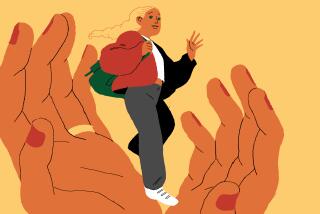Special Day Ironic for Fatherless Children of Fatherless Children : Family: Ronald Jr. will probably grow up not knowing Ronald Sr., as both his parents grew up not knowing their fathers.
- Share via
NEW YORK — Sixteen-year-old Alicia Fanning grew up without a father. So did her sometime boyfriend Ronald, who fathered six children before he was out of his teens.
Now, there is a seventh child, Ronald Jr. And like both his parents, he is growing up without a father around the house.
Happy Father’s Day.
Ronald, 21, won’t spend the day with Ronald Jr. or with Alicia. They’ve just moved to Florida; she didn’t want her year-old son growing up at Red Hook, one more fatherless kid in a tough Brooklyn project.
Not that they saw much of Ronald when they lived there. Red Hook wasn’t his turf; he had other things to do.
“He’s supposed to be working somewhere in the mall sometime soon,” said Alicia hopefully. But so far, Ronald is still unemployed. Still messing around, going with new women, coming up with little moral support or cash.
It would be wrong to say that this isn’t the way Alicia expected things to turn out. The truth is, she had no expectations at all.
Like her pregnancy, this parenthood is not carefully choreographed. It has nothing to do with the family planning and relative order of life in the suburbs. Such stability is something Alicia has never known.
She isn’t a product of the traditional family that Vice President Dan Quayle exhorted last month in a controversial speech. Nor is she anything like the fictional single mother he attacked: the feisty TV character Murphy Brown, a highly educated television journalist who can afford a nanny.
Getting pregnant at 15 was unpremeditated and just romantic enough to sort of carry Alicia along. “I seen my stomach getting bigger and bigger, and I knew,” she said recently, her moon-faced son balanced on one knee. “I knew, but I didn’t think about it. I just kind of went on with my life.”
She was vaguely overwhelmed and, like a lot of adolescents, confused by the adult world at her doorstep. About 500,000 children are born to teen-age mothers each year, with 340,000 of the babies born to white girls like Alicia.
Between 100,000 and 200,000 babies are born each year to fathers between the ages of 15 and 19, but little is known about the long-term financial and emotional contributions these fathers make.
The numbers don’t mean much to Alicia. She doesn’t see herself as part of a larger cyclical story of fatherless children raising fatherless children.
She only sees this son whose tiny infant arms she once feared would break like twigs when she pulled his jumpsuits on. Now Alicia playfully tosses him into the air with ease. They’ve grown used to one another.
“I seen the movies in science class about how babies are made and stuff.” But she didn’t connect action and consequence, “didn’t know it would happen to me.”
Months passed before she went to see a doctor. She skipped the free neonatal and parenting courses, dropped out of high school, stayed indoors a lot, waiting for this alien being inside her to be born.
Some said she should get an abortion. But Alicia was scared it would hurt. The pain of childbirth still seemed far away.
Alicia was just eight months’ pregnant when she stepped off a Brooklyn curb without looking and was struck by a motorcycle. For a terrible moment, it seemed that her baby might die.
“The doctors were running around and yelling all these big words I didn’t know. I didn’t know what the hell was going on,” said Alicia, her gray-green eyes widening. Labor had to be induced, and when her son was born, his lungs were collapsed. When the ordeal was over, adoption was out of the question.
This was her child now. “I didn’t know how it felt to be a mother when I was pregnant. I didn’t know till I thought I was gonna lose him.”
Those first nights were long--Alicia sneaking up to the hospital nursery to make sure that her baby was all right, that he could breathe with all those machines hooked up to him, that he knew his mother was there.
In a way, Ronald Jr. was lucky. Maybe he wasn’t born into a secure nuclear nest. But he was born without alcohol, crack or nicotine in his blood. He was born to a girl who loved and wanted him.
“Some girls there, they just walk out of the hospital and don’t tell no one where they’re going,” Alicia said. “They just walk away.”
Her own father did that. He took off when her mother was four months’ pregnant. Alicia never knew “if he was dead or alive,” hearing only in recent years that he has a wife and son in New Jersey.
“He knew he had a daughter,” she said. “He just didn’t know she was me.”
For a long time, Alicia and her mom were a haphazard team, moving from New York borough to borough, Bronx to Brooklyn, checking out thrift shops and stretching the welfare check as far as it would go.
When the money got really tight, they started going to the Salvation Army and there met the Saggio family. Alicia, who was then just 12, charmed her way into their hearts, and eventually, into their home.
Patricia Saggio, 50, has been a sort of surrogate mother to Alicia, whose own mother has been living in a women’s shelter, where she is being treated for emphysema and arthritis.
“Alicia hasn’t had an easy time,” said Patricia Saggio, who has raised five sons and a daughter of her own. “But she’s a good mother and really loves that baby. She’s like a lot of these kids. She wants something to love. It’s like they’re missing something, like they lacked something in their lives.”
What many teen-age mothers have lacked are basics, such as parental support, education and financial security. Many grow up in poverty, in homes without fathers, in circumstances like those Alicia’s son was born into.
“And that kind of environment means you’re less likely to have sex education or be able to make informed decisions about sex, which means you’re more likely to end up with children having children,” said sociologist Edward Kain, author of “The Myth of Family Decline.”
It’s a cycle that Alicia, despite limited means and vision, would like to break. But her attention span is short, sentences drifting off unfinished, and the long view pretty much is limited to the next box of diapers, the immediate gratification of a snack at the mall.
So even as she says she wants Ronald Jr. to know his father, Alicia has moved to Florida. Patricia Saggio’s eldest son and daughter-in-law have opened their home and are helping Alicia get a high school diploma. It’s a new start.
“I don’t want my son growing up in all the violence,” she said. “I don’t want him out there selling drugs around Red Hook or shooting somebody in the street. I just want him to grow up.”
She will have to work hard to beat the odds, which are stacked against teen-age mothers. But it can be done, said Frank F. Furstenberg Jr., a sociologist at the University of Pennsylvania.
“If the mother completes her education, particularly beyond high school, enters a stable relationship and gets employment, the odds for her and her child are good,” Furstenberg said. “But that’s a lot of ‘ifs.’ ”
What’s sure is Ronald Jr.’s place at the center of Alicia’s universe, even if “he gets on my nerves sometimes.” She wants to marry a solid guy and build a life for her son, maybe have one more child, get a secretarial job, make a home.
“With a white picket fence--that’s what I wanted,” Patricia Saggio added.
Alicia pondered this a moment, her eyes locked in a dreamy gaze. But she snapped out of it quickly: “Yeah, you got a white picket fence all right. Right around the projects. Come on. This is real life.”
More to Read
Get the L.A. Times Politics newsletter
Deeply reported insights into legislation, politics and policy from Sacramento, Washington and beyond. In your inbox twice per week.
You may occasionally receive promotional content from the Los Angeles Times.










